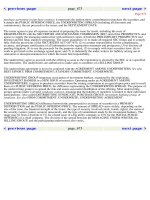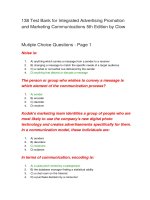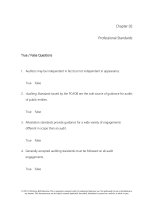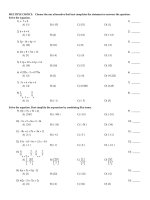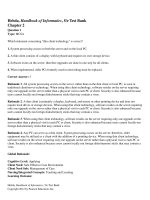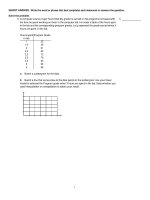research design qualitative quantitative and mixed methods 5th edition
Bạn đang xem bản rút gọn của tài liệu. Xem và tải ngay bản đầy đủ của tài liệu tại đây (4.39 MB, 254 trang )
Creswell, John W., J. Creswell. Research Design, 5th Edition. SAGE Publications, Inc, 20171127.
1
I dedicate this book to all of my mentees and former students over the years who have engaged in this
fascinating process of research and who have welcomed my suggestions for improving their scholarly
works. I also welcome my son, J. David Creswell, a noted psychologist and researcher at Carnegie
Mellon University, as my coauthor.
Creswell, John W., J. Creswell. Research Design, 5th Edition. SAGE Publications, Inc, 20171127.
2
Research Design
Qualitative, Quantitative, and Mixed Methods Approaches
Fifth Edition
•
•
•
•
JohnW.Creswell
DepartmentofFamilyMedicineUniversityofMichigan
J.DavidCreswell
DepartmentofPsychologyCarnegieMellonUniversity
Creswell, John W., J. Creswell. Research Design, 5th Edition. SAGE Publications, Inc, 20171127.
3
FOR INFORMATION:
SAGE Publications, Inc.
2455 Teller Road
Thousand Oaks, California 91320
E-mail:
SAGE Publications Ltd.
1 Oliver’s Yard
55 City Road
London EC1Y 1SP
United Kingdom
SAGE Publications India Pvt. Ltd.
B 1/I 1 Mohan Cooperative Industrial Area
Mathura Road, New Delhi 110 044
India
SAGE Publications Asia-Pacific Pte. Ltd.
3 Church Street
#10-04 Samsung Hub
Singapore 049483
Copyright © 2018 by SAGE Publications, Inc.
All rights reserved. No part of this book may be reproduced or utilized in any form or by any means,
electronic or mechanical, including photocopying, recording, or by any information storage and retrieval
system, without permission in writing from the publisher.
Printed in the United States of America
Library of Congress Cataloging-in-Publication Data
Names: Creswell, John W., author. | Creswell, J. David, author.
Title: Research design : qualitative, quantitative, and mixed methods approaches / John W. Creswell, PhD, Department of
Family Medicine, University of Michigan, and J. David Creswell, PhD, Department of Psychology, Carnegie Mellon
University.
Description: Fifth edition. | Los Angeles : SAGE, [2018] | Includes bibliographical references and index.
Identifiers: LCCN 2017044644 | ISBN 978-1-5063-8670-6 (pbk. : alk. paper)
Creswell, John W., J. Creswell. Research Design, 5th Edition. SAGE Publications, Inc, 20171127.
4
Subjects: LCSH: Social sciences—Research—Methodology. | Social sciences—Statistical methods.
Classification: LCC H62 .C6963 2018 | DDC 300.72/1—dc23 LC record available at />
Acquisitions Editor: Helen Salmon
Content Development Editor: Chelsea Neve
Editorial Assistant: Megan O’Heffernan
Production Editor: David C. Felts
Copy Editor: Amy Marks
Typesetter: C&M Digitals (P) Ltd.
Proofreader: Eleni-Maria Georgiou
Indexer: Stepping Stones Indexing Services
Cover Designer: Janet Kiesel
Marketing Manager: Shari Countryman
Creswell, John W., J. Creswell. Research Design, 5th Edition. SAGE Publications, Inc, 20171127.
5
Brief Contents
1.
2.
3.
4.
5.
6.
AnalyticContentsofResearchTechniques
Preface
CompanionWebsite
Acknowledgments
AbouttheAuthors
PartIPreliminaryConsiderations
1. Chapter1TheSelectionofaResearchApproach
2. Chapter2ReviewoftheLiterature
3. Chapter3TheUseofTheory
4. Chapter4WritingStrategiesandEthicalConsiderations
7. PartIIDesigningResearch
1. Chapter5TheIntroduction
2. Chapter6ThePurposeStatement
3. Chapter7ResearchQuestionsandHypotheses
4. Chapter8QuantitativeMethods
5. Chapter9QualitativeMethods
6. Chapter10MixedMethodsProcedures
8. Glossary
9. References
10. AuthorIndex
11. SubjectIndex
Creswell, John W., J. Creswell. Research Design, 5th Edition. SAGE Publications, Inc, 20171127.
6
Detailed Contents
1. AnalyticContentsofResearchTechniques
2. Preface
1. Purpose
2. Audience
3. Format
4. OutlineofChapters
3. CompanionWebsite
4. Acknowledgments
5. AbouttheAuthors
6. PartIPreliminaryConsiderations
1. Chapter1TheSelectionofaResearchApproach
1. TheThreeApproachestoResearch
2. ThreeComponentsInvolvedinanApproach
1. PhilosophicalWorldviews
1. ThePostpositivistWorldview
2. TheConstructivistWorldview
3. TheTransformativeWorldview
4. ThePragmaticWorldview
2. ResearchDesigns
1. QuantitativeDesigns
2. QualitativeDesigns
3. MixedMethodsDesigns
3. ResearchMethods
3. ResearchApproachesasWorldviews,Designs,andMethods
4. CriteriaforSelectingaResearchApproach
1. TheResearchProblemandQuestions
2. PersonalExperiences
3. Audience
5. Summary
1. ▶WritingExercises
6. AdditionalReadings
2. Chapter2ReviewoftheLiterature
1. TheResearchTopic
2. TheLiteratureReview
1. TheUseoftheLiterature
2. DesignTechniques
1. StepsinConductingaLiteratureReview
2. SearchingComputerizedDatabases
3. APriorityforSelectingLiteratureMaterial
4. ALiteratureMapoftheResearch
5. AbstractingStudies
3. ▶Example2.1.LiteratureReviewAbstractinaQuantitativeStudy
4. ▶Example2.2.LiteratureReviewAbstractinaStudyAdvancinga
Typology
1. StyleManuals
5. TheDefinitionofTerms
6. ▶Example2.3.TermsDefinedinanIndependentVariablesSection
7. ▶Example2.4.TermsDefinedinaMixedMethodsDissertation
8. AQuantitativeorMixedMethodsLiteratureReview
Creswell, John W., J. Creswell. Research Design, 5th Edition. SAGE Publications, Inc, 20171127.
7
3. Summary
1. ▶WritingExercises
4. AdditionalReadings
3. Chapter3TheUseofTheory
1. QuantitativeTheoryUse
1. TestingCausalClaimsinQuantitativeResearch
2. VariablesinQuantitativeResearch
3. DefinitionofaTheoryinQuantitativeResearch
4. FormsofTheoriesinQuantitativeResearch
5. PlacementofQuantitativeTheories
6. WritingaQuantitativeTheoreticalPerspective
7. ▶Example3.1.AQuantitativeTheorySection
2. QualitativeTheoryUse
1. VariationinTheoryUseinQualitativeResearch
2. LocatingtheTheoryinQualitativeResearch
3. ▶Example3.2.ATheoryEarlyinaQualitativeStudy
3. MixedMethodsTheoryUse
1. ▶Example3.3.ATheoryattheEndofaQualitativeStudy
2. SocialScienceTheoryUse
3. Participatory–SocialJusticeTheoryUse
4. Box3.1.Transformative-EmancipatoryQuestionsforMixedMethods
ResearchersThroughouttheResearchProcess
5. ▶Example3.4.TheoryinaFeministMixedMethodsStudy
4. Summary
1. ▶WritingExercises
5. AdditionalReadings
4. Chapter4WritingStrategiesandEthicalConsiderations
1. WritingtheProposal
1. ArgumentsPresentedinaProposal
2. FormatforaQualitativeProposal
3. ▶Example4.1.AQualitativeConstructivist/InterpretivistFormat
4. ▶Example4.2.AQualitativeParticipatory–SocialJusticeFormat
5. FormatforaQuantitativeProposal
6. ▶Example4.3.AQuantitativeFormat
7. FormatforaMixedMethodsProposal
8. ▶Example4.4.AMixedMethodsFormat
9. DesigningtheSectionsofaProposal
2. WritingIdeas
1. WritingasThinking
2. TheHabitofWriting
3. ReadabilityoftheManuscript
4. ▶Example4.5.AnIllustrationoftheHook-and-EyeTechnique
5. Voice,Tense,and“Fat”
3. EthicalIssuestoAnticipate
1. PriortoBeginningtheStudy
2. BeginningtheStudy
3. CollectingtheData
4. AnalyzingtheData
5. Reporting,Sharing,andStoringData
4. Summary
Creswell, John W., J. Creswell. Research Design, 5th Edition. SAGE Publications, Inc, 20171127.
8
1. ▶WritingExercises
5. AdditionalReadings
7. PartIIDesigningResearch
1. Chapter5TheIntroduction
1. TheImportanceofIntroductions
2. AnAbstractforaStudy
3. Qualitative,Quantitative,andMixedMethodsIntroductions
4. AModelforanIntroduction
1. AnIllustration
2. TheResearchProblem
3. StudiesAddressingtheProblem
4. DeficienciesinPastLiterature
5. ▶Example5.1.DeficienciesintheLiterature—NeededStudies
6. ▶Example5.2.DeficienciesintheLiterature—FewStudies
7. SignificanceofaStudyforAudiences
8. ▶Example5.3.SignificanceoftheStudyStatedinanIntroductiontoa
QuantitativeStudy
5. Summary
1. ▶WritingExercises
6. AdditionalReadings
2. Chapter6ThePurposeStatement
1. SignificanceandMeaningofaPurposeStatement
1. AQualitativePurposeStatement
2. ▶Example6.1.APurposeStatementinaQualitativePhenomenology
Study
3. ▶Example6.2.APurposeStatementinaCaseStudy
4. ▶Example6.3.APurposeStatementinanEthnography
5. ▶Example6.4.APurposeStatementinaGroundedTheoryStudy
6. AQuantitativePurposeStatement
7. ▶Example6.5.APurposeStatementinaPublishedSurveyStudy
8. ▶Example6.6.APurposeStatementinaDissertationSurveyStudy
9. ▶Example6.7.APurposeStatementinanExperimentalStudy
10. AMixedMethodsPurposeStatement
11. ▶Example6.8.AConvergentMixedMethodsPurposeStatement
12. ▶Example6.9.AnExplanatorySequentialMixedMethodsPurpose
Statement
13. ▶Example6.10.AnExploratorySequentialMixedMethodsPurpose
Statement
2. Summary
1. ▶WritingExercises
3. AdditionalReadings
3. Chapter7ResearchQuestionsandHypotheses
1. QualitativeResearchQuestions
1. ▶Example7.1.AQualitativeCentralQuestionFromanEthnography
2. ▶Example7.2.QualitativeCentralQuestionsFromaCaseStudy
2. QuantitativeResearchQuestionsandHypotheses
1. ▶Example7.3.ANullHypothesis
2. ▶Example7.4.DirectionalHypotheses
3. ▶Example7.5.NondirectionalandDirectionalHypotheses
Creswell, John W., J. Creswell. Research Design, 5th Edition. SAGE Publications, Inc, 20171127.
9
4. ▶Example7.6.StandardUseofLanguageinHypotheses
5. AModelforDescriptiveQuestionsandHypotheses
6. ▶Example7.7.DescriptiveandInferentialQuestions
3. MixedMethodsResearchQuestionsandHypotheses
1. ▶Example7.8.HypothesesandResearchQuestionsinaMixed
MethodsStudy
2. ▶Example7.9.AMixedMethodsQuestionWrittenUsingMethodsand
ContentLanguage
4. Summary
1. ▶WritingExercises
5. AdditionalReadings
4. Chapter8QuantitativeMethods
1. DefiningSurveysandExperiments
2. ComponentsofaSurveyStudyMethodPlan
1. TheSurveyDesign
2. ThePopulationandSample
3. Instrumentation
4. VariablesintheStudy
5. DataAnalysis
6. InterpretingResultsandWritingaDiscussionSection
7. ▶Example8.1.ASurveyMethodPlan
3. ComponentsofanExperimentalStudyMethodPlan
1. Participants
2. Variables
3. InstrumentationandMaterials
4. ExperimentalProcedures
5. ▶Example8.2.Pre-experimentalDesigns
6. ▶Example8.3.Quasi-experimentalDesigns
7. ▶Example8.4.TrueExperimentalDesigns
8. ▶Example8.5.Single-SubjectDesigns
9. ThreatstoValidity
10. TheProcedure
11. DataAnalysis
12. InterpretingResultsandWritingaDiscussionSection
13. ▶Example8.6.AnExperimentalMethodPlan
4. Summary
1. ▶WritingExercises
5. AdditionalReadings
5. Chapter9QualitativeMethods
1. TheCharacteristicsofQualitativeResearch
2. QualitativeDesigns
3. TheResearcher’sRoleandReflexivity
4. DataCollectionProcedures
5. DataRecordingProcedures
6. DataAnalysisProcedures
7. Interpretation
8. ValidityandReliability
9. WritingtheQualitativeReport
1. ▶Example9.1.QualitativeProcedures
10. Summary
Creswell, John W., J. Creswell. Research Design, 5th Edition. SAGE Publications, Inc, 20171127.
10
1. ▶WritingExercises
11. AdditionalReadings
6. Chapter10MixedMethodsProcedures
1. ComponentsofMixedMethodsProcedures
1. DescribeMixedMethodsResearch
2. TypesofMixedMethodsDesigns
1. ConvergentMixedMethodsDesign
2. ExplanatorySequentialMixedMethodsDesign
3. ExploratorySequentialMixedMethodsDesign
4. SeveralComplexMixedMethodsDesigns
3. AProcedureforEmbeddingCoreDesignsIntoComplexDesigns
4. FactorsImportantinChoosingaMixedMethodsDesign
5. ExamplesofMixedMethodsProcedures
1. ▶Example10.1.AConvergentParallelMixedMethodsDesign
2. ▶Example10.2.AnExplanatorySequentialMixedMethodsDesign
3. ▶Example10.3.AnExploratorySequentialMixedMethodsDesign
4. ▶Example10.4.ASocialJusticeDesign
6. Summary
1. ▶WritingExercises
7. AdditionalReadings
8. Glossary
9. References
10. AuthorIndex
11. SubjectIndex
Creswell, John W., J. Creswell. Research Design, 5th Edition. SAGE Publications, Inc, 20171127.
11
Analytic Contents of Research Techniques
Chapter 1. The Selection of a Research Approach
•
•
•
•
Determining your research approach
Identifying a worldview with which you are most comfortable
Defining the three types of research approaches
Using quantitative, qualitative, and mixed methods designs and methods
Chapter 2. Review of the Literature
•
•
•
•
•
•
•
•
•
Assessing whether your topic is researchable
Using steps in conducting a literature review
Using computerized databases available for reviewing the literature
Developing a priority for types of literature to review
Designing a literature map
Writing a good abstract of a research study
Using important elements of a style manual
Defining terms
Employing a model for writing a literature review
Chapter 3. The Use of Theory
•
•
•
•
•
•
•
Testing causal claims in quantitative research
Identifying variables in a quantitative study
Defining the nature of a quantitative theory
Using a script to write a theoretical perspective into a quantitative study
Considering the types of theories used in qualitative research
Placing theories in a qualitative study
Placing a theoretical lens into a mixed methods study
Chapter 4. Writing Strategies and Ethical Considerations
•
•
•
•
•
•
•
Assessing the structure of a proposal for qualitative, quantitative, and mixed methods studies
Using writing strategies for drafting a proposal
Developing a habit of writing
Constructing umbrella thoughts, big thoughts, little thoughts, and attention thoughts in writing
Developing writing consistency through the hook-and-eye technique
Using principles of writing good prose
Anticipating ethical issues in many phases of the research process
Chapter 5. The Introduction
•
•
•
•
Writing an abstract for a study
Exploring differences among quantitative, qualitative, and mixed methods introductions
Using the deficiency model for writing an introduction
Designing a good narrative hook
Creswell, John W., J. Creswell. Research Design, 5th Edition. SAGE Publications, Inc, 20171127.
12
•
•
•
•
Writing about the research problem
Summarizing the literature about a research problem
Pointing out deficiencies in past literature
Considering audiences that may profit from your study
Chapter 6. The Purpose Statement
•
•
•
•
•
•
Using a script for writing a qualitative purpose statement
Considering how the script would change depending on your qualitative design
Using a script for writing a quantitative purpose statement
Considering how the script would change depending on your quantitative design
Using a script for writing a mixed methods purpose statement
Considering how the script would change depending on your mixed methods design
Chapter 7. Research Questions and Hypotheses
•
•
•
•
•
•
Writing a script for a qualitative central question
Considering how this script would change depending on the qualitative design
Writing a script for quantitative research questions and hypotheses
Considering how this script would change depending on the quantitative design and the
different types of hypotheses
Using a model for descriptive and inferential quantitative questions and hypotheses
Writing scripts for different forms of research questions for a mixed methods study
Chapter 8. Quantitative Methods
•
•
•
•
•
•
•
Using a checklist for survey research to form topic sections of a survey procedure
Employing steps in analyzing data for a survey procedure
Writing a complete survey methods discussion
Using a checklist for experimental research to form sections for an experimental procedure
Identifying the type of experimental procedure that best fits your proposed study
Drawing a diagram of experimental procedures
Identifying the potential internal validity and external validity threats to your proposed study
Chapter 9. Qualitative Methods
•
•
•
•
•
•
Using a checklist for qualitative research to form topic sections of a procedure
Stating the basic characteristics of qualitative research
Determining how reflexivity will be included in a proposed study
Weighing the different types of data collected in qualitative research
Employing steps in the qualitative data analysis process
Establishing validity in qualitative research
Chapter 10. Mixed Methods Procedures
•
•
•
Stating a definition and the characteristics of mixed methods research
Using a convergent mixed methods design
Using an explanatory sequential mixed methods design
Creswell, John W., J. Creswell. Research Design, 5th Edition. SAGE Publications, Inc, 20171127.
13
•
•
•
Employing an exploratory sequential mixed methods design
Using one of the complex mixed methods designs
Choosing which design is best for a mixed methods study
Creswell, John W., J. Creswell. Research Design, 5th Edition. SAGE Publications, Inc, 20171127.
14
Preface
Purpose
This book advances a framework, a process, and compositional approaches for designing a proposal or
research project for qualitative, quantitative, and mixed methods research in the human, health, and social
sciences. The ascendency of qualitative research, the emergence of mixed methods approaches, and the
growth of quantitative designs have created a need for this book’s unique comparison of the three
approaches to inquiry. This comparison begins with preliminary consideration of philosophical
assumptions for all three approaches, a review of the literature, an assessment of the use of theory and
conceptual frameworks in research approaches, and reflections about the importance of writing and ethics
in scholarly inquiry. The book then addresses the key elements in the process of designing and
conducting a research project: writing an introduction; stating a purpose or research aims for the study;
identifying research questions and hypotheses; and advancing methods and procedures for data
collection, analysis, and interpretation. At each step in this process, the reader is taken through
qualitative, quantitative, and mixed methods approaches.
Audience
This book is intended for students and faculty who seek assistance in preparing a plan, proposal, or
research project for a scholarly journal article, a dissertation, a thesis, or an application for funding. At a
broader level, the book may be useful as both a reference book and a textbook for courses in research
methods. To best take advantage of the design features in this book, the reader needs a basic familiarity
with qualitative and quantitative research; however, terms will be explained and defined and
recommended strategies advanced for those needing introductory assistance in the design process.
Highlighted terms in the text and a glossary of the terms at the back of the book provide a working
language for understanding research. This book also is intended for a broad audience in the human,
health, and social sciences. Readers’ comments from the past four editions suggest that individuals using
the book come from many disciplines and fields. We hope that researchers in fields such as marketing,
management, criminal justice, communication studies, psychology, sociology, K–12 education, higher
and postsecondary education, nursing, family medicine, health services research, global health,
behavioral health, urban studies, family research, and other fields of study will find this fifth edition
useful.
Format
In each chapter, we share examples drawn from varied disciplines. These examples are drawn from
books, journal articles, dissertation proposals, and dissertations. Though our primary specialization is in
educational psychology, the health sciences, and in psychology, the illustrations are intended to be
inclusive of many fields. They reflect issues in social justice and examples of studies with marginalized
individuals in our society as well as the traditional samples and populations studied by researchers.
Inclusiveness also extends to methodological pluralism in research today, and the discussion incorporates
alternative philosophical ideas, diverse modes of inquiry, and numerous procedures.
This book is not a detailed method text; instead, we highlight the essential features of research design.
We have attempted to reduce research to its essential core ideas so that researchers can plan a thorough
and thoughtful study. The coverage of research designs is limited to frequently used forms: surveys and
experiments in quantitative research; narrative research, phenomenology, grounded theory, ethnography,
and case studies in qualitative research; and convergent, explanatory sequential, and exploratory
Creswell, John W., J. Creswell. Research Design, 5th Edition. SAGE Publications, Inc, 20171127.
15
sequential designs in mixed methods research. Although students preparing a dissertation proposal should
find this book helpful, topics related to the politics of presenting and negotiating a study with review
committees are addressed thoroughly in other texts.
Consistent with accepted conventions of scholarly writing, we have tried to eliminate any words or
examples that convey a discriminatory (e.g., sexist or ethnic) orientation. Examples were selected to
provide a full range of gender and cultural orientations. Throughout the text we do not favor either
qualitative or quantitative research. Indeed, we have intentionally altered the order of qualitative and
quantitative examples throughout the book. Readers should also note that in the longer examples cited in
this book, many references are made to other writings. Only the reference to the work we use in the
illustration will be cited, not the entire list of references embedded within any particular example. As
with earlier editions, we have maintained features to enhance the readability and understandability of the
material: bullets to emphasize key points, numbered points to stress key steps in a process, and longer
examples of complete passages with annotations to highlight key research ideas that are being conveyed
by the authors.
In this fifth edition of the book, new features have been added in response to developments in research
and reader feedback:
•
•
•
•
•
•
•
•
•
•
•
In this edition, we shape the discussion not only around designing a proposal for a research
project but also around the steps in designing a research study. Thus, the emphasis on designing
a research study (as opposed to focusing only on a proposal) is slightly larger for this edition
than in past editions.
We have added more information about the epistemological and ontological assumptions as
they relate to research questions and methods.
In the worldview section, we now include more on the transformative worldview.
In the methods discussion, we have added more on specific approaches such as case studies,
participatory action research, and visual methods in qualitative research.
Also in the qualitative methods, we have added information about social media and online
qualitative methods. Also, we have added more information on memoing and on reflexivity.
In the mixed methods, we now incorporate information about action research (participatory
research) and program evaluation.
In the respective methods chapters, we have included more on qualitative and quantitative data
analysis software.
In the theory section, we have added information about causality, and then incorporated its
relationship to statistics in the quantitative methods.
For our quantitative, qualitative, and mixed methods sections, we have incorporated sections on
writing discussion sections into each of these methodologies.
We have incorporated new information into all of our methods chapters—quantitative,
qualitative, and mixed methods. Our mixed methods chapter now reflects the latest advances in
the field.
Throughout the book, we have cited updated editions of research methods books that have
emerged since the last edition and added current references and additional readings.
Outline of Chapters
This book is divided into two parts. Part I consist of steps that researchers need to consider before they
develop their proposals or plans for research. Part II discusses the various sections used to develop a
scholarly research proposal for a thesis, dissertation, or a research report.
Creswell, John W., J. Creswell. Research Design, 5th Edition. SAGE Publications, Inc, 20171127.
16
Part I. Preliminary Considerations
This part of the book discusses preparing for the design of a scholarly study. It contains Chapters
1 through 4.
Chapter 1. The Selection of a Research Approach
In this chapter, we begin by defining quantitative, qualitative, and mixed methods approaches. We then
discuss how philosophy, designs, and methods intersect when one uses one of these approaches. We
review different philosophical stances; advanced types of qualitative, quantitative, and mixed methods
designs; and then discuss the methods associated with each design. We also consider the factors that go
into the choice of an approach to research. Thus, this chapter should help proposal developers decide
whether a qualitative, quantitative, or mixed methods approach is suitable for their proposed research
project.
Chapter 2. Review of the Literature
It is important to extensively review the literature on your topic before you design your proposal. Thus,
you need to begin with a researchable topic and then explore the literature using the steps advanced in
this chapter. This calls for setting a priority for selecting material from the literature, drawing a visual
map of studies that relate to your topic, writing good abstracts, employing skills learned from using style
manuals, and defining key terms. This chapter should help researchers thoughtfully consider relevant
literature on their topics and start compiling and writing literature reviews.
Chapter 3. The Use of Theory
Theories serve different purposes in the three approaches inquiry. In quantitative research, they provide a
proposed explanation for the relationship among variables being tested by the investigator. In qualitative
research, they may often serve as a lens for the inquiry or they may be generated during the study. In
mixed methods studies, researchers employ them in many ways, including those associated with
quantitative and qualitative approaches. This chapter helps researchers consider and plan how theory
might be incorporated into their studies.
Chapter 4. Writing Strategies and Ethical Considerations
It is helpful to have an overall outline of the topics to be included in a proposal or research study before
you begin writing. Thus, this chapter begins with different outlines for writing proposals. The outlines
can be used as models depending on whether your proposed study is qualitative, quantitative, or mixed
methods. Then we convey several ideas about the actual writing of the proposal, such as developing a
habit of writing, and grammar ideas that have been helpful to us in improving our scholarly writing.
Finally, we turn to ethical issues and discuss these not as abstract ideas, but as considerations that need to
be anticipated in multiple phases of the research process.
Part II. Designing Research
In Part II, we turn to the components of designing the research proposal. Chapters 5 through 10 address
steps in this process.
Chapter 5. The Introduction
It is important to properly introduce a research study. We provide a model for writing a good scholarly
introduction to your proposal. The chapter begins with designing an abstract for a study. This is followed
Creswell, John W., J. Creswell. Research Design, 5th Edition. SAGE Publications, Inc, 20171127.
17
by developing an introduction to include identifying the research problem or issue, framing this problem
within the existing literature, pointing out deficiencies in the literature, and targeting the study for an
audience. This chapter provides a systematic method for designing a scholarly introduction to a proposal
or study.
Chapter 6. The Purpose Statement
At the beginning of research proposals or projects, authors mention the central purpose or intent of the
study. This passage is the most important statement in the entire research process, and an entire chapter is
devoted to this topic. In this chapter, you learn how to write this statement for quantitative, qualitative,
and mixed methods studies, and you will be provided with scripts that help you design and write these
statements.
Chapter 7. Research Questions and Hypotheses
The questions and hypotheses addressed by the researcher serve to narrow and focus the purpose of the
study. As a major signpost in a project, the set of research questions and hypotheses needs to be written
carefully. In this chapter, you will learn how to write both qualitative and quantitative research questions
and hypotheses, as well as how to employ both forms in writing mixed methods questions and
hypotheses. Numerous examples serve as scripts to illustrate these processes.
Chapter 8. Quantitative Methods
Quantitative methods involve the processes of collecting, analyzing, interpreting, and writing the results
of a study. Specific methods exist in both survey and experimental research that relate to identifying a
sample and population, specifying the type of design, collecting and analyzing data, presenting the
results, making an interpretation, and writing the research in a manner consistent with a survey or
experimental study. In this chapter, the reader learns the specific procedures for designing survey or
experimental methods that need to go into a research proposal. Checklists provided in the chapter help to
ensure that all steps are included.
Chapter 9. Qualitative Methods
Qualitative approaches to data collection, analysis, interpretation, and report writing differ from the
traditional, quantitative approaches. Purposeful sampling, collection of open-ended data, analysis of text
or images (e.g., pictures), representation of information in figures and tables, and personal interpretation
of the findings all inform qualitative methods. This chapter advances steps in designing qualitative
procedures into a research proposal, and it also includes a checklist for making sure that you cover
important procedures. Ample illustrations provide examples from narrative studies, phenomenology,
grounded theory, ethnography, and case studies.
Chapter 10. Mixed Methods Procedures
Mixed methods involves the collection and “mixing” or integration of both quantitative and qualitative
data in a study. It is not enough to only analyze your qualitative and quantitative data. Further analysis
consists of integrating the two databases for additional insight into research problems and questions.
Mixed methods research has increased in popularity in recent years, and this chapter highlights important
developments and provides an introduction to the use of this design. This chapter begins by defining
mixed methods research and the core characteristics that describe it. Then the three core designs in mixed
methods research—(a) convergent, (b) explanatory sequential, and (c) exploratory sequential—are
detailed in terms of their characteristics, data collection and analysis features, and approaches for
interpreting and validating the research. Further, these core designs are employed within other designs
(e.g., experiments), within theories (e.g., feminist research), and within methodologies (e.g., evaluation
Creswell, John W., J. Creswell. Research Design, 5th Edition. SAGE Publications, Inc, 20171127.
18
procedures). Finally, we discuss the decisions needed to determine which one of the designs would be
best for your mixed methods project. We provide examples of the core designs and include a checklist to
review to determine whether you incorporated all of the essential steps in your proposal or project.
Designing a study is a difficult and time-consuming process. This book will not necessarily make the
process easier or faster, but it can provide specific skills useful in research, knowledge about the steps
involved in the process, and a practical guide to composing and writing scholarly research. Before the
steps of the process unfold, we recommend that proposal developers think through their approaches to
research, conduct literature reviews on their topics, develop an outline of topics to include in a proposal
design, and begin anticipating potential ethical issues that may arise in the research. Part I begins with
these topics.
Creswell, John W., J. Creswell. Research Design, 5th Edition. SAGE Publications, Inc, 20171127.
19
Companion Website
The SAGE edge companion site for Research Design, Fifth Edition, is available
at />SAGE edge for Students provides a personalized approach to help students accomplish their coursework
goals.
•
•
•
•
Mobile-friendlyquizzestestunderstandingoftheconceptsfromeachchapter
VideosfeaturingJohnW.CreswellandotherscuratedfromtheSAGEResearchMethods
platformexpandonimportanttopicsinresearchdesign
SAGEJournalarticlesplusaccompanyingexercisesprovideopportunitiestoapply
conceptsfromeachchapter
Sampleresearchproposalsandtemplatesofferfurtherguidanceonresearchdesign
SAGE edge for Instructors supports teaching by making it easy to integrate quality content and create a
rich learning environment.
•
•
•
•
•
•
•
Samplesyllabiassistinstructuringandpreparingacourse
Editable,chapter-specificPowerPoint¯slidesoffereaseandflexibilityincreatinga
multimediapresentation
Adiverserangeofprewrittenandeditabletestquestionshelpassessprogressand
understanding
Lecturenoteshighlightkeyconceptsfromeachchapterandprovideahelpfulreference
andteachingtool
Chapter-specificwritingandpeerreviewexercisesemphasizecriticalthinkingand
applicationoftheconcepts
Discussionquestionsandgroupactivitieslaunchclassroominteractionandencourage
studentstoengagefurtherwiththematerial
Allfiguresandtablesfromthebookavailablefordownload
Creswell, John W., J. Creswell. Research Design, 5th Edition. SAGE Publications, Inc, 20171127.
20
Acknowledgments
This book could not have been written without the encouragement and ideas of the hundreds of students
in the doctoral-level Proposal Development course that John taught at the University of NebraskaLincoln for over 30 years. Specific former students and editors were instrumental in its development: Dr.
Sharon Hudson, Dr. Leon Cantrell, the late Nette Nelson, Dr. De Tonack, Dr. Ray Ostrander, and Diane
Wells. Since the publication of the first edition, John has also become indebted to the students in his
introductory research methods courses and to individuals who have participated in his qualitative and
mixed methods seminars. These courses have been his laboratories for working out ideas, incorporating
new ones, and sharing his experiences as a writer and researcher. In addition, John wants to thank his
staff over the years in the Office of Qualitative and Mixed Methods Research at the University of
Nebraska-Lincoln who have helped to conceptualize content in this book and now those in the
Department of Family Medicine at the University of Michigan. John is especially indebted to the
scholarly work of Dr. Vicki Plano Clark, Dr. Ron Shope, Dr. Kim Galt, Dr. Yun Lu, Dr. Sherry Wang,
Amanda Garrett, and Dr. Alex Morales.
In addition, we are grateful for the insightful suggestions provided by the reviewers for SAGE. We also
could not have produced this book without the generous support and encouragement of our friends at
SAGE. SAGE is and has been a first-rate publishing house. We especially owe much to our former editor
and mentor, C. Deborah Laughton (now of Guilford Press), and to Lisa Cuevas-Shaw and Vicki Knight.
Now we are working under the talented guidance of Helen Salmon, who has been most supportive of our
work and who has encouraged us throughout the process. Lastly, we want to thank all of the SAGE staff
with whom we have had the pleasure to work. We have grown together and helped to develop research
methods as a distinguished, worldwide field. At SAGE, we have also benefited from the contributions of
reviewers to this fifth edition: Clare Bennett, University of Worcester; Kelly Kennedy, Chapman
University; Therese A.G. Lewis, Northumbria University; Andrew Ryder, University of North Carolina
Wilmington; Tiffany J. Davis, University of Houston; Lora L. Wolff, Western Illinois University; Laura
Meyer, University of Denver; Andi Hess, Arizona State University; and Audrey Cund, University of the
West of Scotland.
Creswell, John W., J. Creswell. Research Design, 5th Edition. SAGE Publications, Inc, 20171127.
21
About the Authors
JohnW.Creswell,
PhD,isaprofessoroffamilymedicineandco-directoroftheMichiganMixedMethods
ResearchandScholarshipProgramattheUniversityofMichigan.Hehasauthored
numerousarticlesand28booksonmixedmethodsresearch,qualitativeresearch,and
researchdesign.WhileattheUniversityofNebraska-Lincoln,heheldtheCliftonEndowed
ProfessorChair,servedasdirectorofamixedmethodsresearchoffice,founded
SAGE’sJournalofMixedMethodsResearch,andwasanadjunctprofessoroffamilymedicine
attheUniversityofMichiganandaconsultanttotheVeteransAdministrationhealth
servicesresearchcenter.HewasaSeniorFulbrightScholartoSouthAfricain2008andto
Thailandin2012.In2011,heco-ledanationalworkinggrouponmixedmethodspractices
attheNationalInstitutesofHealth,servedasavisitingprofessoratHarvard’sSchoolof
PublicHealth,andreceivedanhonorarydoctoratefromtheUniversityofPretoria,South
Africa.In2014,hewasthepresidentoftheMixedMethodsInternationalResearch
Association.In2015,hejoinedthestaffofFamilyMedicineattheUniversityofMichigan.
Johnhasbeenteachingresearchmethodscoursesforthepast40years.
J.DavidCreswell,
PhD,isanassociateprofessorofpsychologyanddirectoroftheHealthandHuman
PerformancelaboratoryatCarnegieMellonUniversity.Muchofhisresearchisquantitative
innature,andfocusesonunderstandingwhatmakespeopleresilientunderstress.Hehas
publishedover50peer-reviewedarticles,co-editedtheHandbookofMindfulness(2015,
Guilford),andreceivedearlycareerawardsforhisresearchfromtheAssociationfor
PsychologicalScience(2011),theAmericanPsychologicalAssociation(2014),andthe
Creswell, John W., J. Creswell. Research Design, 5th Edition. SAGE Publications, Inc, 20171127.
22
AmericanPsychosomaticSociety(2017).Theseresearchcontributionscamefroma
childhoodandearlyadulthoodofdiscussingresearchmethodologywithhisdad,sothis
booknowextendsacollaborationgoingbackmanyyears!Davidhasbeenteachingresearch
methodscoursesforthepast9years.
Creswell, John W., J. Creswell. Research Design, 5th Edition. SAGE Publications, Inc, 20171127.
23
Part I Preliminary Considerations
•
•
•
•
Chapter1TheSelectionofaResearchApproach
Chapter2ReviewoftheLiterature
Chapter3TheUseofTheory
Chapter4WritingStrategiesandEthicalConsiderations
This book is intended to help researchers develop a plan or proposal for a research study. Part I addresses
several preliminary considerations that are necessary before designing a proposal or a plan for a study.
These considerations relate to selecting an appropriate research approach, reviewing the literature to
position the proposed study within the existing literature, deciding on whether to use a theory in the
study, and employing—at the outset—good writing and ethical practices.
Creswell, John W., J. Creswell. Research Design, 5th Edition. SAGE Publications, Inc, 20171127.
24
Chapter 1 The Selection of a Research Approach
Research approaches are plans and the procedures for research that span the steps from broad
assumptions to detailed methods of data collection, analysis, and interpretation. This plan involves
several decisions, and they need not be taken in the order in which they make sense to us and the order of
their presentation here. The overall decision involves which approach should be used to study a topic.
Informing this decision should be the philosophical assumptions the researcher brings to the study;
procedures of inquiry (called research designs); and specific research methods of data collection,
analysis, and interpretation. The selection of a research approach is also based on the nature of
the research problem or issue being addressed, the researchers’ personal experiences, and the audiences
for the study. Thus, in this book, research approaches, research designs, and research methods are three
key terms that represent a perspective about research that presents information in a successive way from
broad constructions of research to the narrow procedures of methods.
The Three Approaches to Research
In this book, three research approaches are advanced: (a) qualitative, (b) quantitative, and (c) mixed
methods. Unquestionably, the three approaches are not as discrete as they first appear. Qualitative
and quantitative approaches should not be viewed as rigid, distinct categories, polar opposites, or
dichotomies. Instead, they represent different ends on a continuum (Creswell, 2015; Newman & Benz,
1998). A study tends to be more qualitative than quantitative or vice versa. Mixed methods
research resides in the middle of this continuum because it incorporates elements of both qualitative and
quantitative approaches.
Often the distinction between qualitative research and quantitative research is framed in terms of
using words (qualitative) rather than numbers (quantitative), or better yet, using closed-ended questions
and responses (quantitative hypotheses) or open-ended questions and responses (qualitative interview
questions). A more complete way to view the gradations of differences between them is in the basic
philosophical assumptions researchers bring to the study, the types of research strategies used in the
research (e.g., quantitative experiments or qualitative case studies), and the specific methods employed
in conducting these strategies (e.g., collecting data quantitatively on instruments versus collecting
qualitative data through observing a setting). Moreover, there is a historical evolution to both
approaches—with the quantitative approaches dominating the forms of research in the social sciences
from the late 19th century up until the mid-20th century. During the latter half of the 20th century,
interest in qualitative research increased and along with it, the development of mixed methods research.
With this background, it should prove helpful to view definitions of these three key terms as used in this
book:
•
•
Qualitative research is an approach for exploring and understanding the meaning individuals or
groups ascribe to a social or human problem. The process of research involves emerging
questions and procedures, data typically collected in the participant’s setting, data analysis
inductively building from particulars to general themes, and the researcher making
interpretations of the meaning of the data. The final written report has a flexible structure.
Those who engage in this form of inquiry support a way of looking at research that honors an
inductive style, a focus on individual meaning, and the importance of reporting the complexity of
a situation.
Quantitative research is an approach for testing objective theories by examining the relationship
among variables. These variables, in turn, can be measured, typically on instruments, so that
numbered data can be analyzed using statistical procedures. The final written report has a set
structure consisting of introduction, literature and theory, methods, results, and discussion. Like
qualitative researchers, those who engage in this form of inquiry have assumptions about testing
Creswell, John W., J. Creswell. Research Design, 5th Edition. SAGE Publications, Inc, 20171127.
25


